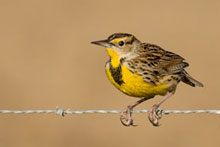Bobolink and Eastern Meadowlark habitats and land development
What you need to know if you want to develop land within the habitat of Bobolink or Eastern Meadowlark.
Effective July 1, 2013.

The law
Ontario’s Endangered Species Act protects endangered or threatened species — animals and plants that are in decline and disappearing from the province.
Bobolink and Eastern Meadowlark are birds that are threatened species.
You either need a permit or to follow certain rules if you want to develop land and it will damage or destroy the habitat of these birds.
You don't need a permit if you plan to develop up to 30 hectares of land, but you need to follow certain rules.
This applies to developing land, such as:
- constructing buildings
- building roads or other infrastructure
- excavating and landscaping
Different rules apply to some forms of development:
- approved under provincial planning laws and
- covered under section 23.2 of Ontario Regulation 242/08
Source law
This is a summary of the provincial laws. You can find a complete set of provincial rules related to this activity in:
This page is for informational purposes only. You should not rely on it to determine your legal obligations. To determine your legal obligations, consult the Endangered Species Act, 2007 and its regulations.
If you need legal advice, consult a legal professional. In the event of an error on this page or a conflict between this page and any applicable law, the law prevails.
Migratory birds
Bobolink and Eastern Meadowlark are migratory birds. Additional rules apply to migratory birds, which are protected under the Migratory Birds Convention Act (a federal law).
Contact Environment Canada for more information about rules covering migratory birds.
Environment Canada – migratory bird regulations
The rules
You must:
- register the work and the affected species with the Ministry of the Environment, Conservation and Parks (before work begins)
- prepare and follow a habitat management plan
- create or enhance habitat, and manage that habitat
- provide a written commitment (also called an undertaking) to the Ministry of the Environment, Conservation and Parks that says you will manage the habitat over time
- minimize effects to the protected species (e.g. put access roads outside the habitat)
- avoid activities that are likely to affect habitat or the birds between May 1 – July 31 (e.g. do not excavate land or plough fields during this time)
- prepare and maintain records that relate to the work and the habitat
- report sightings of rare species (and update registration documents, if needed)
How to register
Habitat management plans
A habitat management plan must be prepared by an expert with knowledge of the species on your land.
The plan must describe:
- the activity — with the proposed start dates
- the habitat that will be affected and created or enhanced, including:
- a map or maps
- where activities will take place (the ecoregion)
- the size of the areas
- how you will create or enhance new habitat and manage it
When to prepare a plan: before activities begin.
You must keep your plan for 5 years after development is complete — and give a copy to the Ministry of the Environment, Conservation and Parks within 14 days, if asked.
Create and enhance habitat
When you create or enhance habitat for the Eastern Meadowlark or Bobolink, you must:
- locate it
- outside of the area you're developing
- within the ecoregion you're developing, or an adjacent ecoregion
- ensure that the new habitat is larger than the previous one
- each parcel of land needs to be more than 4 hectares
- ensure that the new habitat is at least 200 metres wide
- cover 60-80% of the habitat with at least 3 species of grass (1 species must grow higher than 50 cm)
- plant forbs (types of flowering plants that are not grasses) or legumes in areas not covered by grass
This habitat work must be complete within 12 months of the date development begins.
Manage new habitat
You must manage the new or enhanced habitat for at least 5 years:
- maintain the grasses, forbs and legumes in the correct amounts
- remove woody vegetation and invasive species
- avoid harvesting, mowing, cutting or using more than half of the habitat for grazing between April 1-July 31 of any year
Written undertaking
You must also commit in writing to manage the habitat until whatever date comes first:
- 20 years from when you first created or enhanced habitat
- the day the affected habitat is restored and suitable to be used again by the birds
You need to submit this to the Ministry of the Environment, Conservation and Parks before development begins.
Monitoring
You must:
- monitor new or enhanced habitat for 5 years
- conduct at least 3 surveys every year when the birds are likely there (in most areas of Ontario, this is usually between May 1-July 15)
Reporting process
You must prepare and maintain a record that:
- describes the steps you took to minimize effects on the birds
- describes how you created or enhanced and managed habitat
- includes photographs of the new habitat
- provides data and information collected during monitoring
- details any encounters with the species
You must keep your record until December 31 of the year you complete your monitoring — and give a copy to the Ministry of the Environment, Conservation and Parks, if asked.
When you need a permit
You could still need a permit if development:
- affects more than 30 hectares of habitat
- could also affect species other than Bobolink and Eastern Meadowlark
To apply for a permit, contact the Ministry of the Environment, Conservation and Parks.
Identify a species at risk
If you are unsure about a certain species — and would like help identifying or confirming what it is — you can see photos and get more information on the Endangered Species website.